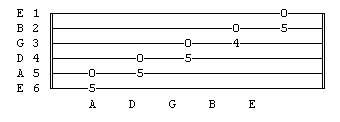|
In the absence of a tuner or a piano, a guitar can be tuned to itself. But first of all, let's talk about how you should not tune the guitar to itself:
- Do not tune using chords. Tuning the guitar using specific chords will make the guitar sound harmonically pleasing when listening to those specific chords, but will often sound horrid when changing to other chords.
- Do not tune using 7th-fret harmonics. Tuning using these harmonics favors perfect intervals, which will result in the guitar actually being somewhat out of tune across the range of the guitar.
Here's why these methods do not work: most music created in the western hemisphere typically uses equal tempered tuning, which is not built upon perfect intervals. Therefore tuning using specific chords or the wrong harmonics will favor perfect intervals and result in those intervals sounding wonderful but other intervals sounding badly out of tune.
For more information, see Appendix E - How To Tune The Guitar To Perfection and Appendix F - An Explanation of the Equal-Tempered Scale.
The general concept for tuning a guitar to itself is to pick a string and tune all other strings starting from that string. I generally pick on my A string, and I adjust it until it sounds about right. (I'm guessing, of course.)
After getting my A string where I want it, I tune my low (6th) E string by playing the A string open and the 6th string while playing the 5th fret. Next, I tune the D (4th) string by playing the 4th string open and the 5th string while playing the 5th fret. This technique works for every string except when tuning the B (2nd) string to the G (3rd) string, where you need to play the 4th fret.
The following illustration shows what this looks like...

This isn't a perfect approach, but in a pinch it does quite nicely.
The best way to tune a guitar to itself is to work with unison and octave pitches whenever possible. For instance:
- Tune your two E strings together by playing them both open.
- Tune the A string by playing it open while sounding an A on the 6th string at the 5th fret.
- Tune the D string by:
- Playing an E on the 2nd fret of the 4th string while sounding the 1st or 6th string open.
- Playing the D string open while sounding an D on the 6th string at the 10th fret.
- Tune the G string by:
- Playing the G string open while sounding an G on the 1st or 6th string at the 3rd fret.
- Playing an A on the 2nd fret of the 3rd string while sounding the 5th string open.
- Tune the B string by playing an E on the 5th fret of the 2nd string while sounding the 1st or 6th string open.
For additional ideas, see Appendix E - How To Tune The Guitar To Perfection.

|